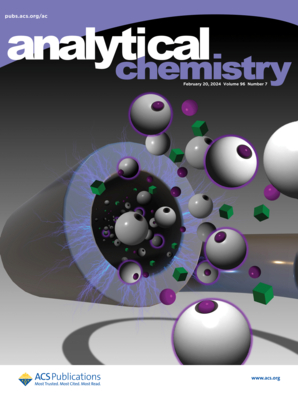Chemical and Acoustical Mixed-Mapping of Geological Materials from Laser-Induced Plasmas: A Comprehensive Approach to Differentiate Mineral Phases
IF 6.7
1区 化学
Q1 CHEMISTRY, ANALYTICAL
引用次数: 0
Abstract
The acoustic wave produced alongside laser-induced plasmas can be used in conjunction with the recorded atomic spectra of plasma emission to expand the physicochemical information acquired from a single inspection event. Among the most interesting uses of acoustic information is the differentiation of mineral phases with similar optical responses coexisting in geological targets. In addition, laser-induced plasma acoustics (LIPAc) can provide data related to the inspected material's hardness, density, and compactness. In this paper, we present a dual acoustic–optic laser-based strategy for the generation of high-resolution surface images of mineral samples. By combining simultaneous multimodal LIBS (laser-induced breakdown spectroscopy) and LIPAc spectral data from laser-induced plasmas, we explore the mineralogical composition of rocks embedded in resin matrixes to distinguish their chemical composition as well as their crystal phases based on physical changes caused by the different spatial arrangements of the constituent atoms. The multispectral polyhedron created by merging singular optical maps, one per detected elements, and the coincidental acoustic map enhance the distinction between regions present within the matrix of a host rock as compared to the differentiation yielded by each technique when used separately. The chemical information guides the composition of the mineral phases in the host rock. Then, the physical information obtained from acoustics may reinforce the identification of the detected mineral phase, draw the geological history of the inspected section, and showcase possible transformations, mainly of polymorphic nature. To test the combination proposed herein, we also inspected a septarian nodule featuring an ensemble of mineral phases with different origins. Mixed optical and acoustic responses from laser-produced plasmas of this complex sample allowed us to obtain more specific information. This approach constitutes a reliable and high-throughput tool for studying the surface of geological samples, which can substantially supplement well-established techniques for mineralogical analysis such as Raman spectroscopy and X-ray diffraction.

激光诱导等离子体地质材料的化学和声学混合绘图:区分矿物相的综合方法
与激光诱导等离子体同时产生的声波可与记录的等离子体发射原子光谱结合使用,以扩展从单次检测活动中获取的物理化学信息。声学信息最有趣的用途之一是区分地质目标中同时存在的具有类似光学响应的矿物相。此外,激光诱导等离子体声学(LIPAc)还能提供与被检测材料的硬度、密度和密实度相关的数据。在本文中,我们介绍了一种基于声光激光的双重策略,用于生成矿物样品的高分辨率表面图像。通过同时结合多模态激光诱导击穿光谱(LIBS)和激光诱导等离子体的 LIPAc 光谱数据,我们探索了嵌入树脂基体中的岩石的矿物成分,从而根据组成原子的不同空间排列所引起的物理变化来区分它们的化学成分及其晶相。与每种技术单独使用时所产生的区分效果相比,通过合并每个检测元素的奇异光学图谱和重合声学图谱而形成的多光谱多面体,可提高对主岩基质内各区域的区分度。化学信息可指导主岩中矿物相的组成。然后,从声学中获得的物理信息可以加强对检测到的矿物相的识别,绘制检测剖面的地质历史,并展示可能发生的转变,主要是多晶体性质的转变。为了测试本文提出的组合方法,我们还检测了一个具有不同成因的矿物相组合的节理结核。通过激光产生的等离子体对这一复杂样本的混合光学和声学响应,我们获得了更多具体信息。这种方法是研究地质样品表面的可靠、高通量工具,可以大大补充拉曼光谱和 X 射线衍射等成熟的矿物学分析技术。
本文章由计算机程序翻译,如有差异,请以英文原文为准。
求助全文
约1分钟内获得全文
求助全文
来源期刊

Analytical Chemistry
化学-分析化学
CiteScore
12.10
自引率
12.20%
发文量
1949
审稿时长
1.4 months
期刊介绍:
Analytical Chemistry, a peer-reviewed research journal, focuses on disseminating new and original knowledge across all branches of analytical chemistry. Fundamental articles may explore general principles of chemical measurement science and need not directly address existing or potential analytical methodology. They can be entirely theoretical or report experimental results. Contributions may cover various phases of analytical operations, including sampling, bioanalysis, electrochemistry, mass spectrometry, microscale and nanoscale systems, environmental analysis, separations, spectroscopy, chemical reactions and selectivity, instrumentation, imaging, surface analysis, and data processing. Papers discussing known analytical methods should present a significant, original application of the method, a notable improvement, or results on an important analyte.
 求助内容:
求助内容: 应助结果提醒方式:
应助结果提醒方式:


